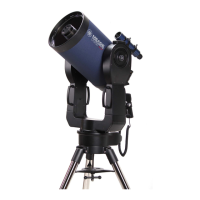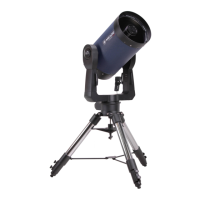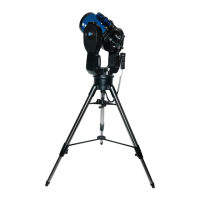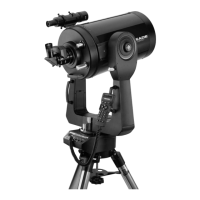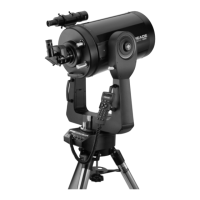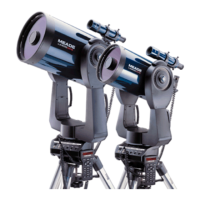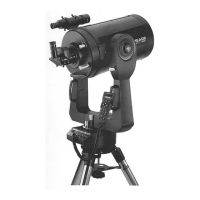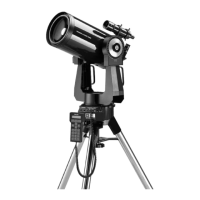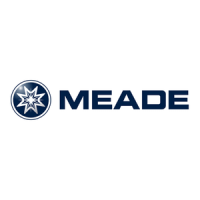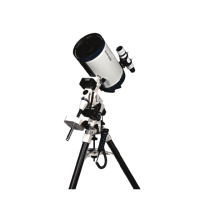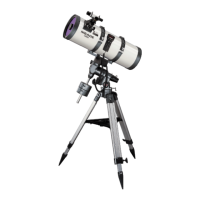Do you have a question about the Meade LX200 R and is the answer not in the manual?
Detailed steps for assembling and securing the telescope to its tripod.
Overview of AutoStar II's user-friendly interface and extensive object library.
Highlights of the AutoStar II system, including object access and guided tours.
Explanation of the two-line display and the purpose of each key on the handbox.
Guide to using Arrow, ENTER, MODE, and Number keys for menu navigation and functions.
Steps for assembling the tripod and attaching the telescope to it.
Instructions for manual slewing and focusing for terrestrial and celestial viewing.
Guide to slewing the telescope using the hand controller's arrow keys.
Detailed steps for using the microfocuser for precise image focusing.
Procedure for initializing and performing automatic telescope alignment using GPS.
Detailed steps for the automatic alignment process, including finding North and syncing with stars.
How to use AutoStar II to automatically track celestial objects after alignment.
Description of libraries like Solar System, Constellation, Deep Sky, and Star.
Configuring settings like alignment, date, time, and mount type.
Setting movement limits, adjusting backlash, and calibrating sensors.
Fine-tuning polar alignment for long-exposure photography using the drift method.
Performing drive training to improve tracking accuracy for astrophotography.
Accessing and adjusting the microfocuser speed settings.
Manual alignment methods other than automatic alignment.
Aligning the telescope using two bright stars selected by AutoStar II.
Manual two-star alignment, including setting home position.
Performing drive training for R.A. and Dec. axes to correct periodic errors.
Using T-Adapters and T-Mounts to attach a 35mm camera body for photography.
Guidelines for cleaning telescope optics, including warnings and recommended methods.
Detailed steps for adjusting the secondary mirror housing for optical alignment.
How to interpret defocused star images to diagnose optical misalignment.
Using star images to perform final adjustments for optimal optical alignment.
Technical details for the 8-inch and 10-inch LX200R models.
Introduction to polar alignment and celestial coordinate systems.
Steps for performing rough polar alignment by locating Polaris.
Fine-tuning polar alignment using a drift method with a crosshair eyepiece.
Using AutoStar II's different polar alignment methods for setup.
Steps for training telescope motors to improve pointing accuracy using a terrestrial target.
Overview of Smart Mount for improving telescope pointing accuracy and centering objects.
Procedures for training Smart Mount to correct pointing errors.
Detailed steps for assembling and securing the telescope to its tripod.
Overview of AutoStar II's user-friendly interface and extensive object library.
Highlights of the AutoStar II system, including object access and guided tours.
Explanation of the two-line display and the purpose of each key on the handbox.
Guide to using Arrow, ENTER, MODE, and Number keys for menu navigation and functions.
Steps for assembling the tripod and attaching the telescope to it.
Instructions for manual slewing and focusing for terrestrial and celestial viewing.
Guide to slewing the telescope using the hand controller's arrow keys.
Detailed steps for using the microfocuser for precise image focusing.
Procedure for initializing and performing automatic telescope alignment using GPS.
Detailed steps for the automatic alignment process, including finding North and syncing with stars.
How to use AutoStar II to automatically track celestial objects after alignment.
Description of libraries like Solar System, Constellation, Deep Sky, and Star.
Configuring settings like alignment, date, time, and mount type.
Setting movement limits, adjusting backlash, and calibrating sensors.
Fine-tuning polar alignment for long-exposure photography using the drift method.
Performing drive training to improve tracking accuracy for astrophotography.
Accessing and adjusting the microfocuser speed settings.
Manual alignment methods other than automatic alignment.
Aligning the telescope using two bright stars selected by AutoStar II.
Manual two-star alignment, including setting home position.
Performing drive training for R.A. and Dec. axes to correct periodic errors.
Using T-Adapters and T-Mounts to attach a 35mm camera body for photography.
Guidelines for cleaning telescope optics, including warnings and recommended methods.
Detailed steps for adjusting the secondary mirror housing for optical alignment.
How to interpret defocused star images to diagnose optical misalignment.
Using star images to perform final adjustments for optimal optical alignment.
Technical details for the 8-inch and 10-inch LX200R models.
Introduction to polar alignment and celestial coordinate systems.
Steps for performing rough polar alignment by locating Polaris.
Fine-tuning polar alignment using a drift method with a crosshair eyepiece.
Using AutoStar II's different polar alignment methods for setup.
Steps for training telescope motors to improve pointing accuracy using a terrestrial target.
Overview of Smart Mount for improving telescope pointing accuracy and centering objects.
Procedures for training Smart Mount to correct pointing errors.
| Optical Design | Schmidt-Cassegrain |
|---|---|
| Focal Length | 2000 mm |
| Focal Ratio | f/10 |
| Mount Type | Fork Mount |
| GoTo Capability | Yes |
| Motorized | Yes |
| Tracking | Yes |
| Finder Scope | 8x50 |
| Weight | 60 lbs (27.2 kg) |
| Eyepiece | 26 mm |
| Aperture | 8 inches (203 mm) |
